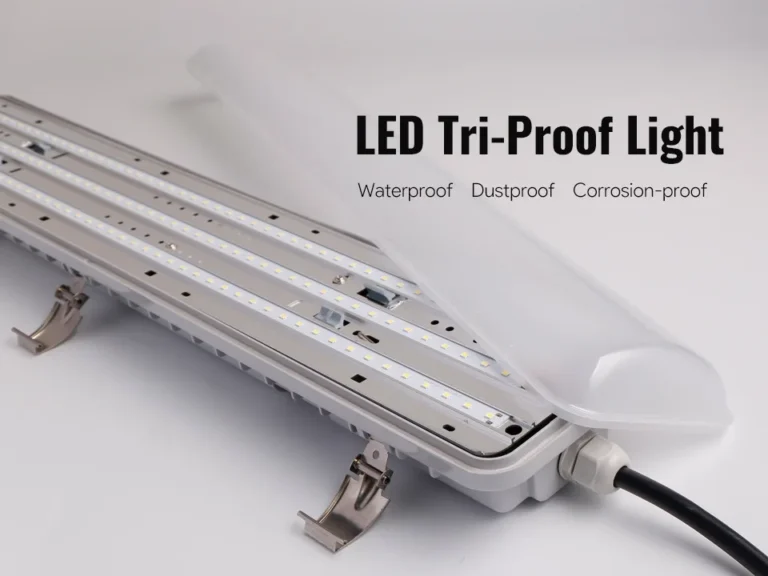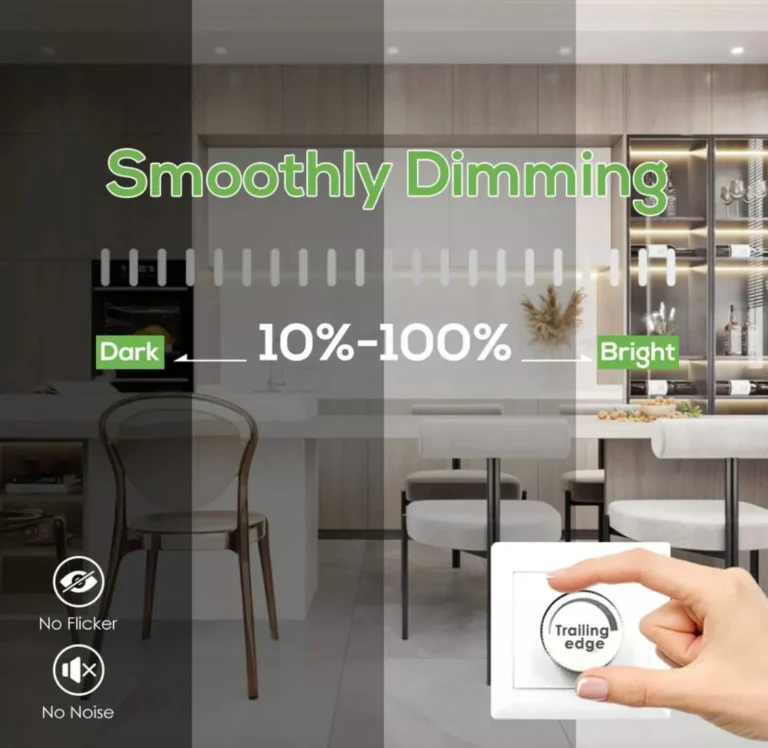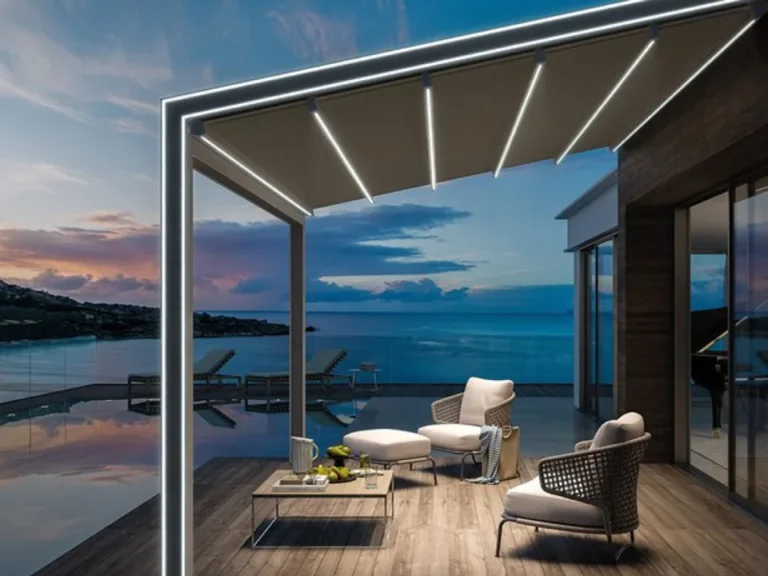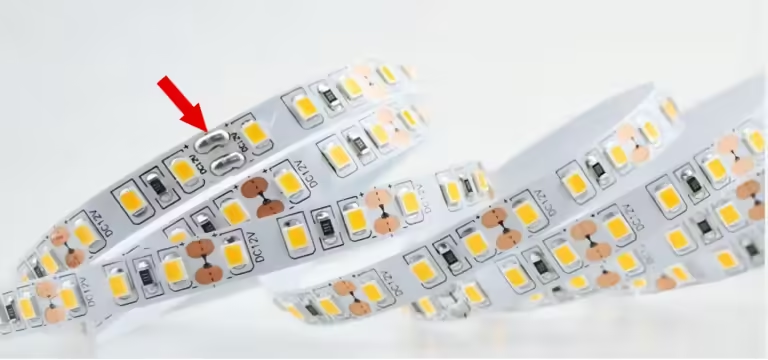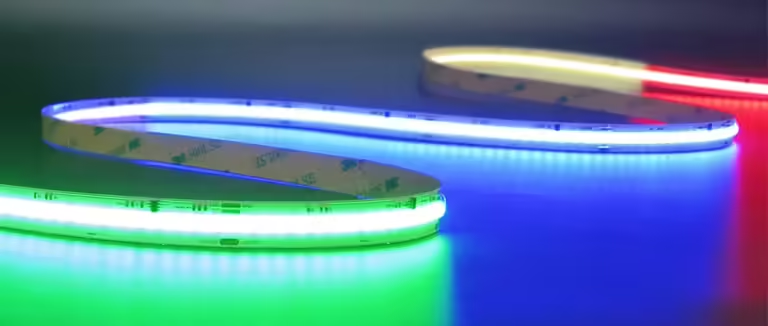Jeśli chodzi o dynamiczne oświetlenie RGB, większość ludzi myśli o niskich napięciach adresowalnych pasków DC. Jednak w ostatnich latach nastąpiła cicha zmiana — więcej wykonawców i specjalistów od oświetlenia wybiera adresowalne światła LED do AC do projektów na dużą skalę na świeżym powietrzu i architekturze. Dlaczego? Ponieważ paski AC RGB mogą działać do 50 metrów bez spadku napięcia, nie wymagają nieporęcznego zasilania i zapewniają wygodę wtycz-and-play. Podczas gdy paski DC oferują doskonałą kontrolę i elastyczność, wersje AC wygrywają w prostocie, odległości i opłacalności — zwłaszcza w regionach 110V lub 220V. W tym artykule omówimy kluczowe różnice między adresowalnymi paskami LED AC i DC i pomożemy Ci zdecydować, który z nich jest właściwym wyborem dla Twojego następnego projektu.

Jakie są adresowalne światła paskowe AC?
Adresowalne diody LED z paskiem AC to paski RGB wysokiego napięcia, które mogą wyświetlać dynamiczne efekty świetlne bez konieczności zasilania niskiego napięcia. Zaprojektowane do pracy bezpośrednio z wejściem 110V lub 220V AC, paski te przekształcają prąd zmienny na prąd stały wewnętrznie za pomocą wbudowanego obwodu prostownika, co pozwala na spójną i bezpieczną pracę.
W przeciwieństwie do standardowych pasków adresowalnych DC, które wymagają zewnętrznego kontrolera i zasilacza, paski AC RGB często są dostarczane w zestawach typu plug-and-play, co czyni je idealnymi do instalacji na duże odległości – do 50 metrów w jednym przejeździe – bez spadku jasności.
Paski te są zwykle częściowo adresowalne, co oznacza, że każdy segment (często 1 metr lub pół metra) może wyświetlać różne kolory lub efekty pościgu, w zależności od wbudowanego typu IC.
Typowe opcje IC obejmują:
SM16703/SM16716: Obsługuje dynamiczne efekty dynamiczne na poziomie segmentu.
TM1934 lub podobny: często używany w wodoodpornych aplikacjach zewnętrznych.
Wewnętrzne układy scalone oparte na MCU: niestandardowe układy scalone wbudowane w moduły sterowników AC dla określonych efektów.
Kluczowe cechy:
Działa bezpośrednio z napięciem 110V lub 220V
Długie jednobiegowe możliwości (do 50 m)
Opcje wodoodporne IP65–IP68
Łatwa instalacja, idealna do oświetlenia zewnętrznego lub komercyjnego
Mogą pracować bez kontrolera z programami bulit-in
Jakie są adresowalne światła LED z adresem DC?
Adresowalne diody LED z adresami DC to paski RGB niskiego napięcia, które umożliwiają sterowanie oświetleniem na poziomie pikseli za pomocą zewnętrznych kontrolerów. Zwykle działają przy napięciu 5V, 12V lub 24V DC i są szeroko stosowane w projektach oświetleniowych dekoracyjnych, oznakowań i animacji.
Istnieją dwa główne typy sterowania:
SPI (seryjny interfejs peryferyjny):
Idealny do złożonych efektów świetlnych i kontroli pikseli. Każda dioda LED (lub grupa) ma swój własny adres.
Wspólne układy scalone: WS2812B, WS2811, SK6812, UCS1903, APA102.
DMX (cyfrowy multipleks):
Stosowany w profesjonalnych systemach oświetleniowych, takich jak oświetlenie sceniczne, eventowe i elewacyjne budynków.
Wspólne układy scalone: TM512, TM1934, SM17512, UCS512C.
Paski adresowalne DC oferują elastyczność, płynne efekty i precyzję, ale wymagają kontrolera i zasilania. Najlepiej nadają się do krótkich i średnich przebiegów ze względu na ograniczenia spadku napięcia.
Jeśli chcesz dowiedzieć się więcej o DC Addressable LED Strip Lights, zapoznaj się z naszym dogłębnym przewodnikiem tutaj: Porównanie taśm LED adresowalnych pikselowo: DMX512 vs. SPI

Adresowalna taśma LED AC vs DC: jaka jest różnica?
Wybór między AC i DC Addresowable LED Strip Diods zależy od potrzeb Twojego projektu — czy to prostota instalacji, precyzja sterowania, bezpieczeństwo czy wydajność na odległość.
Paski adresowalne AC są przeznaczone do bezpośredniego podłączenia do 110V lub 220V, dzięki czemu idealnie nadają się do projektów na zewnątrz lub na dużą skalę, gdzie mają największe znaczenie dla długich przebiegów i szybkiej instalacji. Paski te zwykle oferują efekty na poziomie segmentu (np. co 50 cm lub 1 m) i są wyposażone w kontroler typu plug-and-play. Nie jest potrzebne zewnętrzne zasilanie i może osiągnąć nawet 50 metrów w jednym przejeździe bez zauważalnego spadku jasności.
Z drugiej strony paski adresowalne DC działają na bezpiecznej mocy niskiego napięcia (5V/12V/24V) i oferują kontrolę na poziomie pikseli. Obsługują bogate efekty animacji i są szeroko stosowane w oznakowaniu, aranżacji wnętrz, ustawieniach gier i instalacjach interaktywnych. Wymagają jednak zewnętrznych zasilaczy, spadek napięcia staje się problemem po kilku metrach, a instalacja jest bardziej złożona.
Krótko mówiąc, AC = prostota i odległość, podczas gdy DC = kontrola i precyzja.
| Cecha | Pasek adresowalny AC | Pasek adresowalny DC |
| Napięcie robocze | 110V / 220V AC | 5V/12V/24V DC |
| Typ kontroli | Poziom segmentu (efekty podstawowe) | Piksel na poziomie (precyzyjne sterowanie za pomocą SPI/DMX) |
| Maksymalna długość przebiegu | do 50 metrów | 5–10 metrów (wymaga wtrysku zasilania) |
| Wymagane zasilanie | NIE (wbudowany prostownik) | Tak (zewnętrzny sterownik i kontroler) |
| Instalacja | trzask i gra | Wymaga okablowania i konfiguracji |
| Bezpieczeństwo | Wyższe ryzyko napięcia (ochrona wymaga) | Niskie napięcie, bezpieczniejsze do obsługi |
| Elastyczność | Sztywna lub półelastyczna | Wysoka elastyczność |
| Typowe zastosowania | Fasady zewnętrzne, oświetlenie komercyjne | Znaki, animacje, dekoracja wnętrz |
| Efektywność kosztowa | Niższy koszt całkowity dla długich biegów | Wyższy koszt dzięki akcesoriom |
Plusy i minusy AC RGB adresowalne światła LED paski LED
Jak każde rozwiązanie oświetleniowe, adresowalne paski LED RGB AC mają zarówno zalety, jak i ograniczenia. Zrozumienie ich może pomóc Ci wybrać odpowiedni produkt do aplikacji — zwłaszcza w projektach oświetlenia na dużą skalę lub na zewnątrz.
Zalety:
Długie ciągłe biegi (do 50m)
Nie ma potrzeby wtrysku zasilania ani wzmacniaczy sygnału. Idealny do budowy fasad, korytarzy lub obwodów obwodowych.
Instalacja typu plug-and-play
Nie ma potrzeby stosowania zewnętrznych zasilaczy prądu stałego ani złożonego okablowania. Oszczędzaj na pracy i czasie instalacji.
Niższy koszt systemu
Mniej akcesoriów (zasilacze, wzmacniacze itp.) sprawia, że paski AC są bardziej przyjazne dla budżetu dla dużych projektów.
Wysokie opcje wodoodpor
Wiele modeli jest wyposażonych w ochronę IP65–IP68, idealnie nadające się do użytku na zewnątrz w deszczu, kurzach lub śniegu.
Wbudowane opcje sterowania
Większość pasków zawiera podstawowy kontroler z dynamicznymi efektami, takimi jak pogoń za kolorami, oddychanie i miganie — gotowe do użycia od razu po wyjęciu z pudełka.
Wady:
Ograniczona kontrola pi
Paski AC zazwyczaj obsługują tylko efekty segmentowe, a nie animacje na diodę LED. Nie nadaje się do projektów o doskonałej rozdzielczości lub oświetlenia interaktywnego.
Wyższe napięcie = wyższe ryzyko bezpieczeństwa
Bezpośrednie podłączenie do 110V lub 220V wymaga starannego obchodzenia się i odpowiedniego wodoodpornego uszczelnienia, aby uniknąć zagrożeń elektrycznych.
Mniej elastyczny kształt
Paski AC są często sztywniejsze niż odpowiedniki DC ze względu na konstrukcję obwodu wewnętrznego, co utrudnia ich zginanie lub ciasne kształtowanie.
Nie jest idealny do instalacji bliskiego zasięgu
Ze względu na bezpieczeństwo i ciepło listwy AC RGB lepiej nadają się do instalacji poza zasięgiem lub na zewnątrz.
Gdzie są używane adresowalne paski LED AC?
Dzięki długiej długości trwania, wodoodpornej ochronie i konstrukcji typu plug-and-play, adresowalne taśmy LED są szeroko stosowane w projektach na dużą skalę i na zewnątrz, gdzie kluczowa jest szybka instalacja i szerokie pokrycie. Oto kilka typowych aplikacji:
1. Oświetlenie fasady budynku
Paski AC RGB są idealne do wyznaczania wieżowców, komercyjnych placów i zabytków architektonicznych. Dzięki nawet 50 metrów na szpulę zmniejszają złożoność okablowania, zapewniając jednocześnie dynamiczne efekty kolorystyczne na długich dystansach. Wersje o stopniu ochrony IP67 mogą wytrzymać deszcz i wiatr przez cały rok.

2. Most i dekoracja tunelowa
W projektach infrastrukturalnych, takich jak mosty, tunele i wiadukty, paski adresowalne AC zapewniają żywe efekty liniowe przy minimalnej konserwacji. Ich wejście wysokiego napięcia sprawia, że są kompatybilne z miejskimi systemami zasilania, a hydroizolacja zapewnia bezpieczne użytkowanie w odsłoniętych środowiskach.

3. Centrum handlowe lub komercyjne oświetlenie obwodowe
Używane wzdłuż linii dachów, wejść lub krawędzi okien, paski te mogą tworzyć przyciągające uwagę animacje świetlne, które poprawiają nocny wygląd budynku. Wbudowane kontrolery upraszczają okablowanie, oszczędzając czas wykonawcom pracującym w napiętych terminach.
4. Festiwal na świeżym powietrzu lub instalacje świąteczne
W przypadku tymczasowych instalacji, takich jak Boże Narodzenie, Nowy Rok lub wydarzenia miejskie, paski AC umożliwiają szybką konfigurację przy minimalnych akcesoriach. Ich konstrukcja z wtyczką eliminuje potrzebę stosowania zewnętrznych sterowników, dzięki czemu są idealne dla wykonawców oświetlenia sezonowego.
Wybór między AC i DC RGB LED Strip: Którego potrzebujesz?
Przy podejmowaniu decyzji między adresowalnymi paskami LED RGB AC i DC właściwy wybór zależy od celów projektu, środowiska instalacji i budżetu. Każdy typ ma swoje mocne strony – nie chodzi o to, który z nich jest lepszy, ale który pasuje do Twoich potrzeb.
Wybierz pasek LED AC RGB, jeśli:
Musisz zainstalować długie przebiegi (do 50 metrów) bez spadku napięcia lub wtrysku mocy.
Projekt jest zewnętrzny lub komercyjny, taki jak oświetlenie elewacji, granice oznakowania lub cechy krajobrazu.
Chcesz szybszą instalację z mniejszą liczbą komponentów — wystarczy podłączyć i grać.
Pracujesz bezpośrednio ze źródłami zasilania 110 V lub 220 V i chcesz zminimalizować akcesoria.
Wolisz opłacalne oświetlenie na dużą skalę z kontrolą na poziomie segmentu.
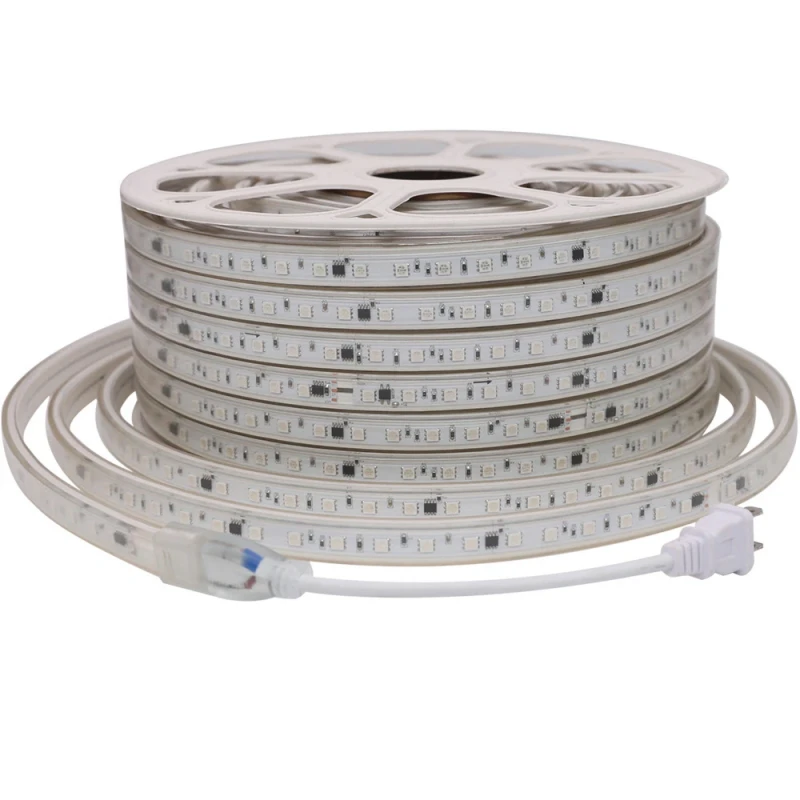
Adresowalna taśma LED AC 110V/220V
Nr modelu: EAA10T060G
Napięcie wejściowe: AC110V/220V
Watt: 10W/m
ILOŚĆ diod LED: SMD5050 60 diod LED/m
Temperatura barwowa: adresowalny RGB
Stopień ochrony IP: IP68
Długość do cięcia: 1000mm
Długość: 50 metrów/rolka
Gwarancja: 2 lata
Cena: 3USD
Wybierz pasek LED DC RGB, jeśli:
Potrzebujesz precyzyjnej kontroli pikseli, takiej jak pojedyncze animacje LED lub zaawansowane efekty.
Twoja aplikacja jest wewnątrz lub dekoracyjne, jak oznakowanie, gabloty lub pokoje do gier.
Wymagana jest elastyczna instalacja w krzywych, narożach lub niestandardowych kształtach.
Masz doświadczenie lub wsparcie dla kontrolerów, zasilaczy i programowania.
Oświetlenie jest częścią interaktywnego lub kreatywnego systemu, takiego jak programy oparte na DMX lub efekty SPI.
Jeśli chcesz kupić DC Address Address RGB LED Strip Light, kliknij tutaj, aby sprawdzić więcej produktów: Adresowalne światło paska DC
W skrócie:
AC = prostszy, dłuższy, zewnętrzny
DC = inteligentniejsze, elastyczne, szczegółowe sterowanie
Nadal nie masz pewności? Możliwe jest również podejście hybrydowe — niektóre projekty wykorzystują paski AC do oświetlenia obwodowego i paski DC do stref animacji ogniskowych.
Jak bezpiecznie używać świetlówek LED 110V/220V AC
Chociaż paski LED AC RGB zapewniają wygodę i wydajność na długich dystansach, działają przy wysokim napięciu (110V lub 220V), co wymaga większej dbałości o bezpieczeństwo podczas instalacji i użytkowania. Poniżej znajdują się kluczowe wytyczne zapewniające bezpieczną i niezawodną pracę w środowiskach komercyjnych i zewnętrznych:
1. Użyj wodoodpornych złączy i zaślepek
Zawsze uszczelnij oba końce paska za pomocą wodoodpornych złączy IP65+ i zaślepek wypełnionych silikonem. Zapobiega to wnikaniu wody i zwarciom, zwłaszcza w instalacjach zewnętrznych lub półotwartych.
2. Zamontuj paski poza zasięgiem
Ze względu na wysokie napięcie, unikaj umieszczania pasków, w których ludzie mogą ich bezpośrednio dotykać. Zainstaluj je wzdłuż wysokich ścian, sufitów, okapów lub za dyfuzorami, aby zmniejszyć ryzyko.
3. Wybierz certyfikowane produkty
Używaj wyłącznie pasków z certyfikatem CE, ETL lub UL, aby zapewnić zgodność ze standardami bezpieczeństwa. Niezawodne wewnętrzne sterowniki i materiały ognioodporne są niezbędne do stabilnej wydajności.
4. Użyj ochrony przed wyciekiem (RCD/RCBO)
Zawsze instaluj urządzenia prądowe (RCD) lub RCBO w obwodzie zasilania. Te wyłączniki bezpieczeństwa natychmiast odcinają zasilanie w przypadku wycieku lub zwarcia, chroniąc zarówno ludzi, jak i mienie.
5. Unikaj zwijania podczas pracy
Nigdy nie uruchamiaj pasków LED AC, gdy jest zwinięty lub szczelnie zapętlony, ponieważ może to spowodować przegrzanie. Zawsze instaluj je całkowicie rozwleczone na powierzchni rozpraszającej ciepło, takiej jak kanały aluminiowe lub PVC.
6. Oznacz i zabezpiecz wszystkie punkty zasilania
Wyraźnie zaznacz wszystkie punkty przyłączeniowe AC i użyj tulei termokurczliwych lub izolowanych skrzynek, aby chronić odsłonięte zaciski. Utrzymuj skrzynki kontrolne i interfejsy zasilania chronione przed wilgocią i wandalizmem.
Podejmując te środki ostrożności, instalacja paska AC RGB jest nie tylko genialna, ale także bezpieczna, trwała i zgodna z międzynarodowymi standardami.

Adresowalne AC adresowalne RGB LED taśmy świetlne fabryk
Szukasz kompleksowego dostawcy dla pasków LED RGB adresowalnych AC i DC?
Signlite oferuje pełną gamę wysokiej jakości rozwiązań oświetleniowych RGB do projektów komercyjnych, architektonicznych i dekoracyjnych.
Produkujemy zarówno paski pikselowe 110V/220V AC RGB, jak i paski pikselowe 5V/12V/24V DC, obsługujące wszystko, od konturów długodystansowych po szczegółowe oświetlenie animacji. Niezależnie od tego, czy potrzebujesz wygody typu plug-and-play, czy kontroli na poziomie pikseli, mamy dla Ciebie ochronę.
Wspieramy również personalizację — długość, poziom wodoodporności, efekty kolorystyczne i metody kontroli można dostosować do potrzeb projektu.
